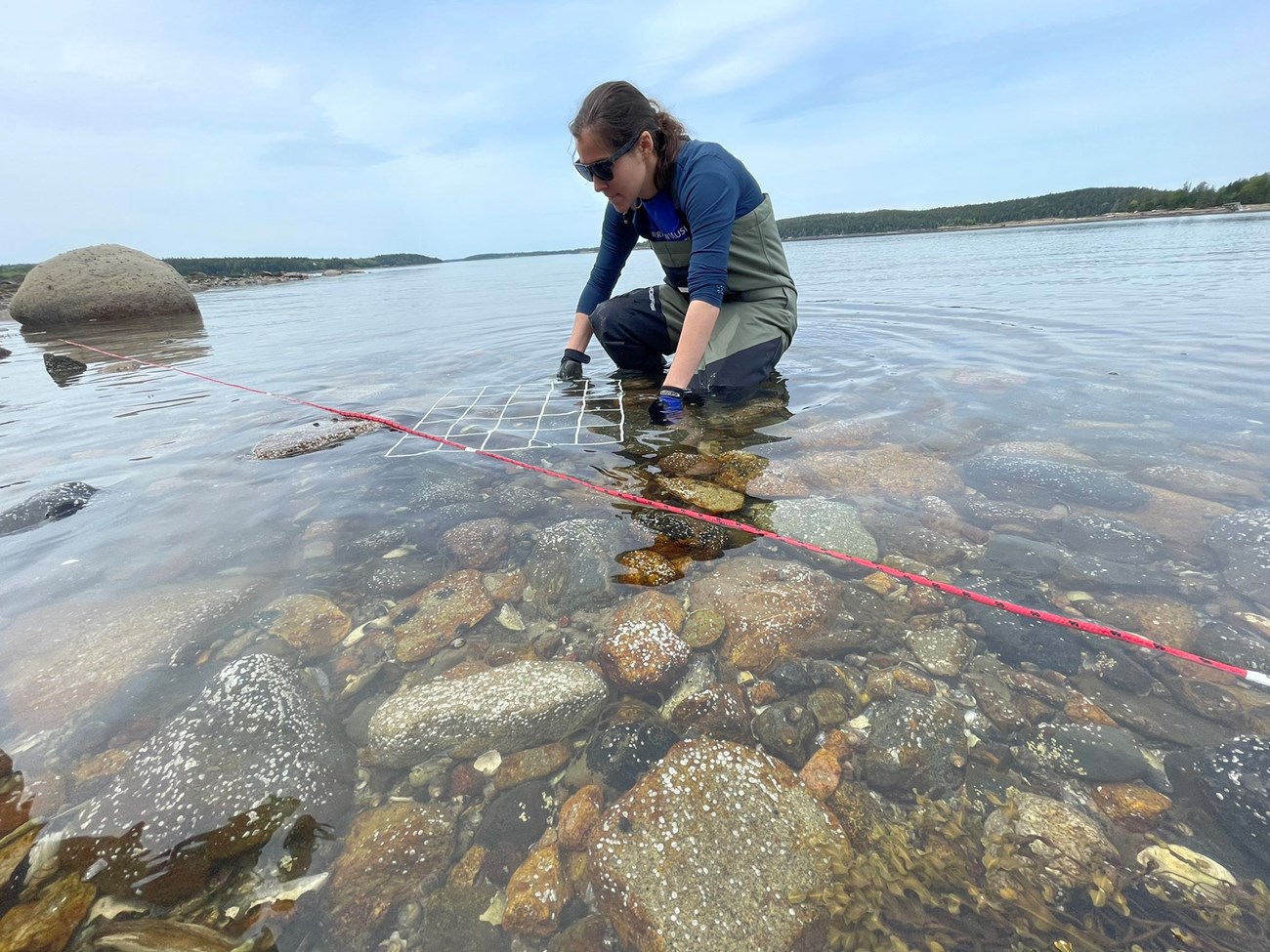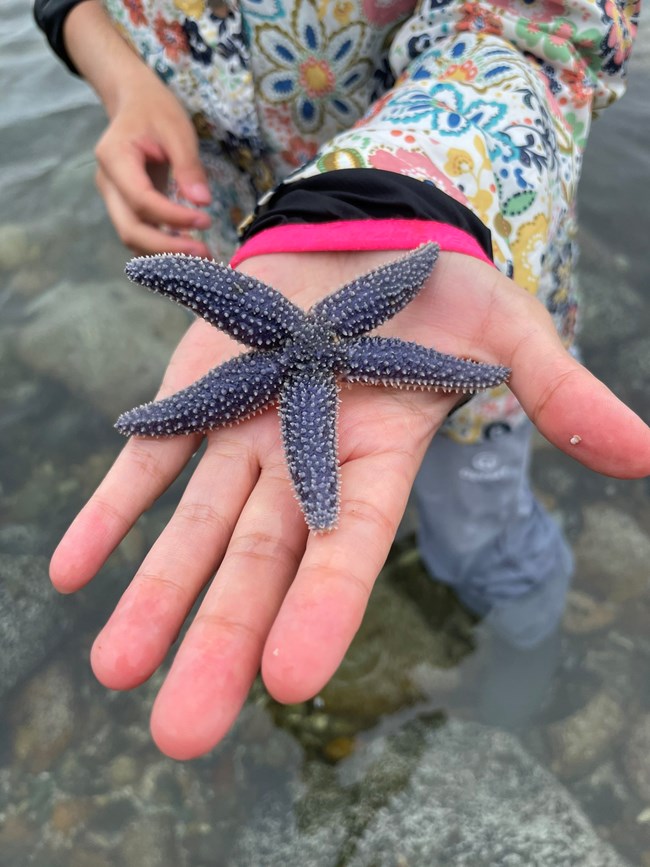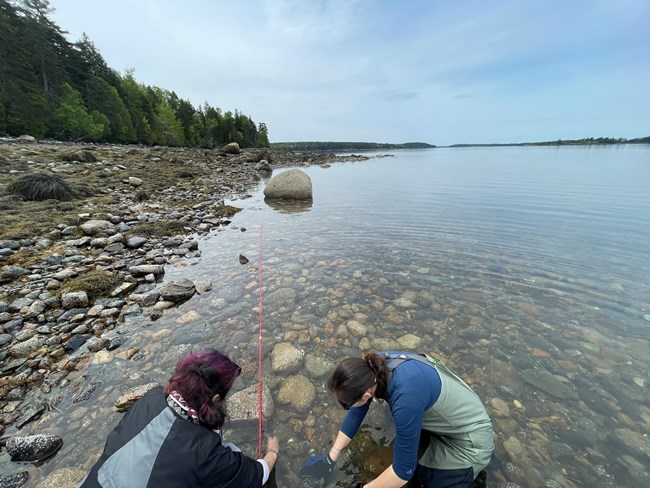Last updated: February 24, 2022
Article
Seeking Sea Stars

Eliot Dudik/Schoodic Institute
In the cool damp caverns between boulders, and the wet surfaces of stones, sea stars tighten their grip on granite. Dark red, brown, and purple, their five arms are marked by lines of dull white spines. They are the Forbes sea star (Asterias forbesi) and the northern sea star (Asterias rubens), two of ten different kinds of sea star in the Gulf of Maine.

Eliot Dudik/Schoodic Institute
Previously called starfish but now referred to by scientists as sea stars because they are not fish, sea stars are invertebrates, animals without backbones, and their spiny skin makes them Echinoderms, related to sea urchins and sand dollars.
Sea stars are top predators, consuming a variety of foods but with a preference for blue mussels. By consuming mussels, which tend to dominate the rocky shore, sea stars help free up space for others, increasing the diversity of the intertidal zone. This disproportionately large effect on the ecosystem makes them a “keystone” species. And like other forms of life in the intertidal zone, sea stars are adapted to being alternately exposed and flooded as the tide comes in and out.
“Sea stars are really unique animals that have adapted to living in this zone of extremes that can be wet or dry, cold or hot,” said Melina Giakoumis, a Ph.D. candidate at the City University of New York who has traveled all over the North Atlantic, from Florida up the U.S. East Coast to Canada, Iceland, and Europe, documenting and collecting sea stars as part of her Ph.D. research investigating the history of two species of Asterias sea star in the North Atlantic.
She is a super seeker of sea stars. Any place where she has encountered sea stars in the past, she can remember exactly where they were. When she goes to a new shoreline, she checks iNaturalist for posted sea star observations to help narrow down locations. When she arrives at a beach she can feel it in her bones, a kind of sixth sense for the five-armed that tells her there are sea stars here.
Giakoumis wasn’t always this sea star savvy. She grew up in Queens and spent a lot of time at Long Island’s sandy beaches, where she became familiar with scallops, whelks, moon snails, razor clams, and horseshoe crabs, but not sea stars.
She went to college at Adelphi University in New York, where she majored in environmental studies and anthropology, then graduate school at Columbia University (thesis: “Population Genetics of Pallas’s Cats (Otocolobus manul) in Mongolia”). Her interest in genetics led to a job as a technician at the American Museum of Natural History in New York City, analyzing genetic data of wildlife, from big cats and whales to insects and bacteria.

Eliot Dudik/Schoodic Institute
Recalling her lifelong interest in the intertidal zone, she decided to focus on marine invertebrates when she went back to graduate school for her Ph.D. in 2017.
She traveled around North Atlantic shorelines, collecting sea stars to find out how their DNA reflected breeding between the two Asterias sea star species - a hybrid zone that aligns with the Gulf of Maine. This was the work that helped her develop her skills at finding sea stars, including back on the Long Island beaches of her youth, where she finally found sea stars while snorkeling the subtidal waters.
Lately, however, her sea star sense has been slipping, because she can’t seem to find them anywhere.
Being a super-seeker of sea stars, she knew that on the Pacific Coast, sea stars were suffering from a mysterious wasting disease, and that other researchers had linked sea star declines with warming waters. She knew there had been small, isolated outbreaks of wasting disease along the Atlantic Coast, and that the cause remained unclear. Because sea stars occupy the margins of both the marine and terrestrial realms, she knew, they are subject to threats from both realms: warming air and water temperatures, ocean water that is becoming more acidic as it absorbs more carbon dioxide from the air, and rising sea levels.
Her own experience collecting sea stars suggested sea stars had declined. She wanted to know if what she was observing reflected a real trend in abundance.
The most recent study of Asterias sea star populations in the Northeastern United States was conducted in 1979. Giakoumis decided to go back and survey the same locations.
This summer, supported by a Second Century Stewardship fellowship from Schoodic Institute and the National Park Service, she visited 13 sites along the Gulf of Maine coast, including all six of the locations studied in 1979.
At Pretty Marsh one sunny morning in July, she and research assistant Andrea Calderon Brito, who is pursuing her master’s degree at CUNY, set up five 5-meter transects parallel to the shoreline in both the intertidal and subtidal zones.
Working slowly along the measuring line, they turned over rocks, looking for sea stars. They also made note of baby scallops, chiton, barnacles, and other animals clinging to the rocks. Giakoumis measured the weight and length of each sea star, and added up the measurements to get a total sea star “biomass” for each beach. These are the same methods used in the 1979 study.
After the sea stars were weighed and measured, Giakoumis selected several for tissue sampling and removed a few of their tube feet--which the sea stars can easily regenerate--and then returned all the sea stars to their original locations. She placed the tube feet tissue samples in vials with a solution to preserve their DNA. She will send the samples to the American Museum of Natural History's Ambrose Monell Cryogenic Collection, a permanent collection of frozen tissue for use in future scientific studies.
Giakoumis and Calderon Brito repeated the process at four more transects, and then moved out into the relatively deeper water below the low tide line. They wore masks and snorkels and worked mostly underwater, as the tide rolled in and the sun climbed higher in the hot July sky.
In total, they found 47 sea stars at Pretty Marsh, of all different sizes, at a density of more than four per square meter in the intertidal. This would turn out to be many more sea stars than every other site she visited.
In the Boston Harbor Islands, she found just a few sea stars below the low tide line, in deeper water where temperatures are cooler. At Cape Cod National Seashore near Provincetown, where Giakoumis previously found sea stars, she saw only one. At the sites that were studied in 1979, there were drastic declines in sea star abundance.
The closest historic sampling location to Pretty Marsh is Grindstone Neck in Winter Harbor, which in 1979 had an average of 15 sea stars per square meter in the intertidal, and 4-5 per 1/4 m2 (or 18.4 per m2) in the subtidal. Many now have no sea stars at all.
What is a sea star super-seeker to do? Giakoumis is now trying to figure out what is causing the disappearance of sea stars, and where they might be found in the future. For now, she is encouraged by the Pretty Marsh sea stars, and thinks the shelter provided by Acadia National Park explains their abundance, at least partially. Such protected intertidal areas will become more andmore important as the Gulf of Maine shoreline continues to change.
Story by Catherine Schmitt, Science Communication Specialist, Schoodic Institute at Acadia National Park
